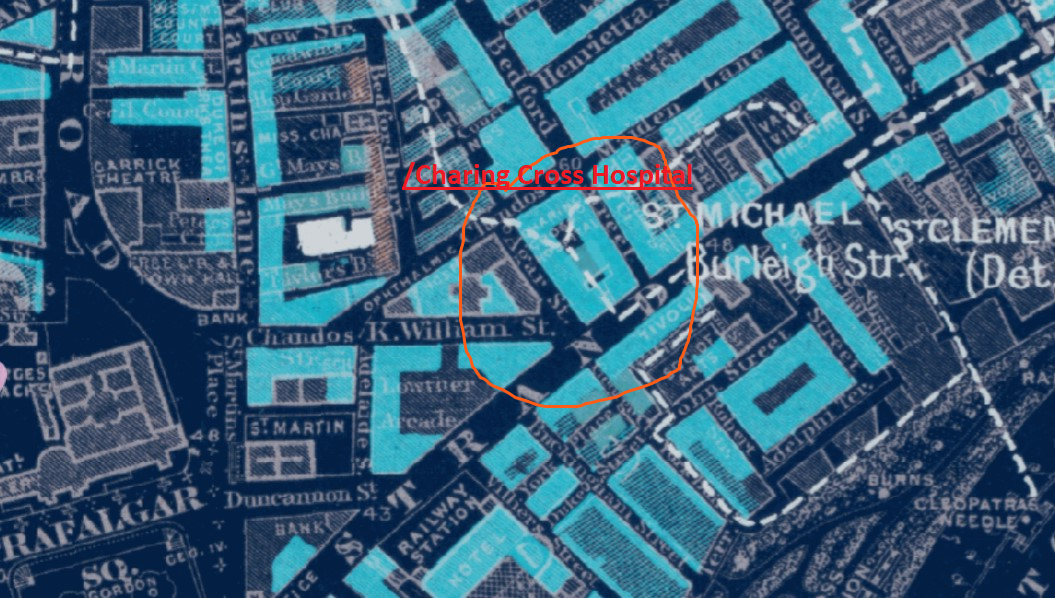Charing Cross Hospital
Charing Cross Hospital is an acute general teaching hospital located in Hammersmith, London, United Kingdom. The present hospital was opened in 1973, although it was originally established in 1818, approximately five miles east, in central London.
It is part of Imperial College Healthcare NHS Trust and is a teaching hospital of the Imperial College School of Medicine. It is a tertiary referral centre for neurosurgery, and is a national centre of excellence for gestational trophoblastic disease. It currently houses the serious injuries center for West London. In recent times, the hospital has pioneered the clinical use of CT scanning.
The hospital is host to the West London Neuroscience Centre. In addition, a day surgery unit, the Riverside Wing, was recently added. The West London Mental Health NHS Trust also has buildings on site. The hospital hosts the largest and oldest gender identity clinic in the country, with 150 operations performed annually.
History
19th century
Suffolk Street, Westminster, the home of the hospital from 1818 to 1821 Charing Cross Hospital in Agar Street, Westminster, the home of the hospital from 1834 to 1973
In 1818, Dr. Benjamin Golding established the 'West London Infirmary and Dispensary' at 16 Suffolk Street, behind the Haymarket Theatre. The infirmary had been the dream of Dr. Golding, who wanted to establish a place of healing for the poor. The then Duke of York and Albany was asked to become patron; he accepted, and the hospital was thenceforth known as the Royal West London Infirmary. Following this, the then-Duchess of York and Albany and Duke of Cambridge also became patrons.[4]
In 1821, the infirmary was reaching capacity, treating nearly 10,000 patients a year, so a new site was found, at 28 Villiers Street, near Charing Cross in the heart of the metropolis. The infirmary had room for twelve beds. Shortly afterwards, a plan was put in place to establish a medical school alongside the infirmary. In 1829, the Charing Cross Hospital Medical School was recognised by the newly founded University of London though the school had been training doctors since 1822. Over the years, the list of benefactors and patrons grew, including many from the Royal Family.[4]
In 1827, the name of the Royal West London Infirmary was changed to the more appropriate 'Charing Cross Hospital'. Plans were drawn up by architect Decimus Burton in 1830 and a site was found, just off the Strand (at what is today Agar Street). On 15 September 1831 the foundation stone was laid by the Duke of Sussex. The first completed ward was named after the daughter of the Duchess of Kent, Princess Victoria, who eventually became Queen Victoria. The principal ward for men was named Golding Ward, after the founder. The hospital itself was completed in January 1834, at a total cost of £20,000, and in October of that year, the 22 medical students were transferred from Villiers Street to the new building.
The hospital and medical school continued to expand. When King's College London opened, it needed a medical school and offered Charing Cross a substantial amount of money to train their students. Dr Golding was opposed to the idea and in 1839, after several years of negotiation, King's College decided to set up their own medical school. During those years, the school saw difficult times, and the number of students enrolling plummeted. By 1840, faith in the school had been restored and the number of students increased dramatically; however, Dr. Golding suffered a stroke.
By 1854 the hospital was flourishing and the top floor, which had been left as an empty shell, was completed. In 1856 Dr. Golding retired as Director of Charing Cross Hospital Medical School. The hospital encountered hard times after several new hospitals, with larger medical schools, were established in central London.[4] However, Charing Cross Hospital weathered the storm: in 1866 it had professional nursing staff, and the hospital was enlarged several times over the next few years – in fact, after a major rebuild in 1877 the hospital had doubled in size.
20th century
Accident and Emergency Department in Fulham Palace Road, which has been home to the hospital since 1973 Henry Moore sculpture at the main entrance
The hospital was further extended in 1902. In 1926, the Royal Westminster Ophthalmic Hospital was merged with Charing Cross Hospital.[4] With the advent of the Blitz in 1940, the hospital staff, students, equipment and patients were moved to Chaulden House, Boxmoor, Hertfordshire. In 1947, the hospital moved back to Charing Cross.[5]
After the Second World War it was decided to relocate the hospital away from central London. Several sites were considered including a large site at Northwick Park in Harrow. However, the University of London deemed that they would not be able to remain affiliated with the hospital should it move there, and the site was handed over to the Ministry of Health, who developed it into the present Northwick Park Hospital.
